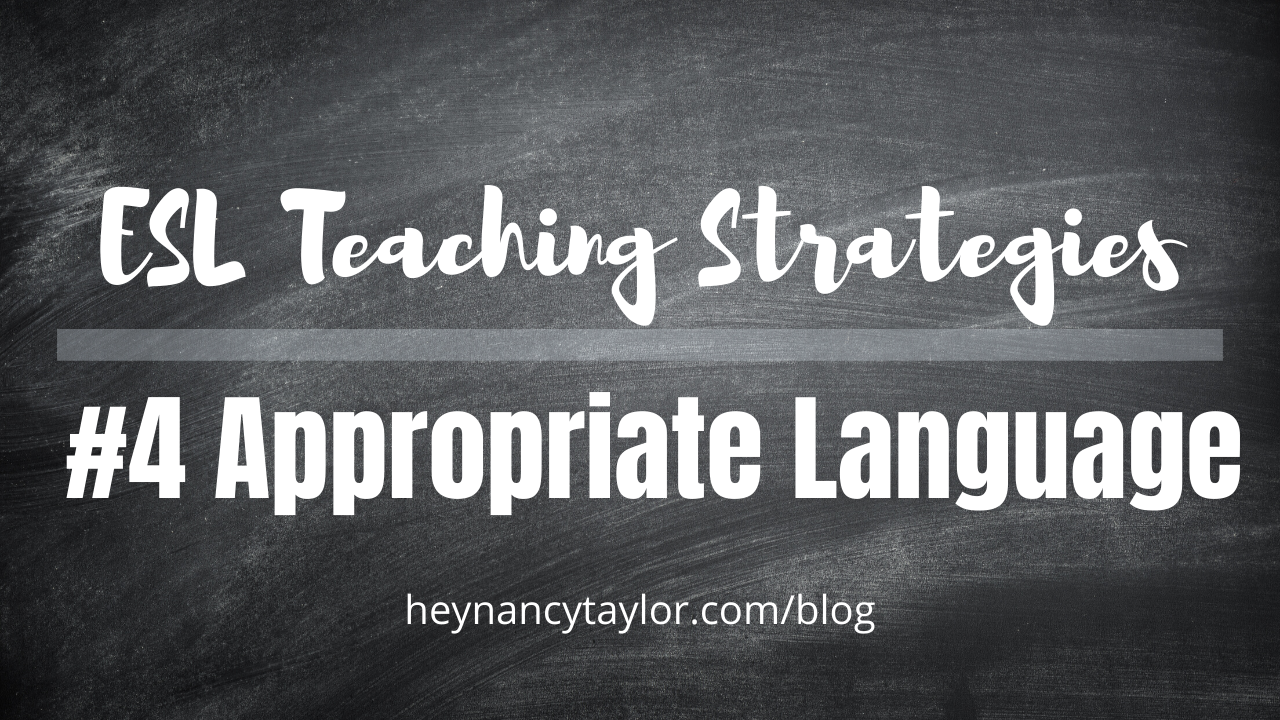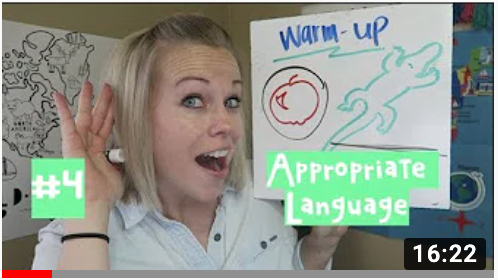ESL Teaching Strategies: #4 Appropriate Language

Time for another teaching strategy to use in your ESL classroom! Woohoo! In this post we are talking all about ESL Appropriate Language. You will learn what it is, why we need to use it, and how to use it including examples you can practice and integrate into your teaching. You can also see the other teaching strategies I have posted by clicking the pictures below:
Here is a video from Nancy explaining this strategy where you can see it in action in the actual classroom.
What is ESL Appropriate Language?
We are not talking about the professional appropriate language here (although keep the potty talk away from the classroom). No, no this is all about the words you use to adjust to the level of your student. Different levels require a different wording and sentence structure as to not confuse the learner or hinder their progression.
A perfect place to start with knowing what is appropriate language is in the lesson vocabulary, objectives, and sentence patterns. From there you see (even slide by slide) the appropriate language to use with each student on that lesson.

If you aren't certified for certain levels, try taking the workshop on Trial lessons. This will allow you to see the trial class slides for all the levels and you can see the adjustments you need to make from levels 1-6.
Another resource out there is this FB group which includes the online lesson bank to see all of the VIPKID lessons so you can prepare.
Why do we use ESL appropriate language?
Now, there are many reasons why VIPKID does not give you a script to follow when you teach the slides. One of them is to adjust for the individual on your screen. Appropriate language allows you to customize the lesson for the learner.
With the lower levels any incidental language will hinder the student. Try to stay away from transition phrases like "we are going to...". Using the correct grammar, use these words without adding confusing transition phrases.
- Use the student's name
-Simple verbs (circle, click, drag drop, look)
-rewards (good job, high five, star)
-Vocabulary (words to focus on during the lesson)
With these lower leveled students be slow and deliberate with the words you choose to use.

With the upper level students the danger in using inappropriate ESL language is that you will slow their progression with speaking too simply.
You do not necessary need to read and have them repeat as often as the lower levels. Assess where they are at and be sure not to slow them down.
Remember there is not a script that we need to read vertabim. Adjusting to the level of the learner with your language will help the student learn the objectives effectively.
How do we use ESL Appropriate Language?

With the lower level students you will need to break down the the words or phrases in each slide to help the student understand the meaning behind each word being said. Use more props, tpr, keep words in isolation, and repeating what the teacher says.
With the upper level students you can add in more of the transitional phrases and make your teaching more of a conversation as they start to understand more language. Use positive correction with pronunciation, expect full sentence responses, and ask deep thinking extension questions.
Here is an example of the same level 3 slide being taught to a student who is lower and one who is higher.

First take a look at the teacher tips to see your objectives and suggestions for how to teach this slide.

Lower level adaptation:
T circles hat "What is he wearing?"
S answers "Hat"
T guides student to answer in a full sentence
Upper level adaptation:
T circles child #6 "What is he wearing?"
S is guided to answer "He is wearing a red hat, green shirt, yellow shorts and pink shoes."
Extenstion: T "What are you wearing?"
Hopefully with this example you are able to see the difference between the abilities and understanding of the different levels of students and see how you can adapt your language to meet their needs.

I hope you found this information helpful as an online ESL teacher and if you aren't a VIPKID teacher yet, click here to apply.
Stay tuned for more ESL teaching strategies coming soon!






